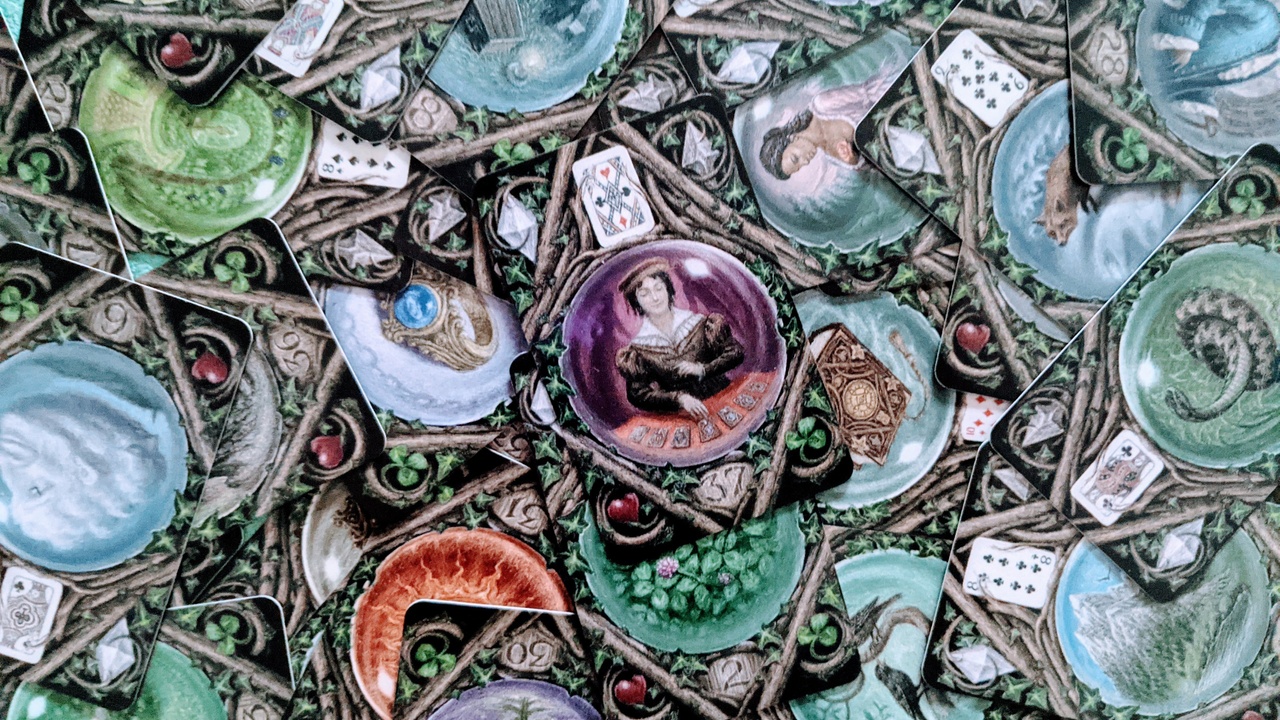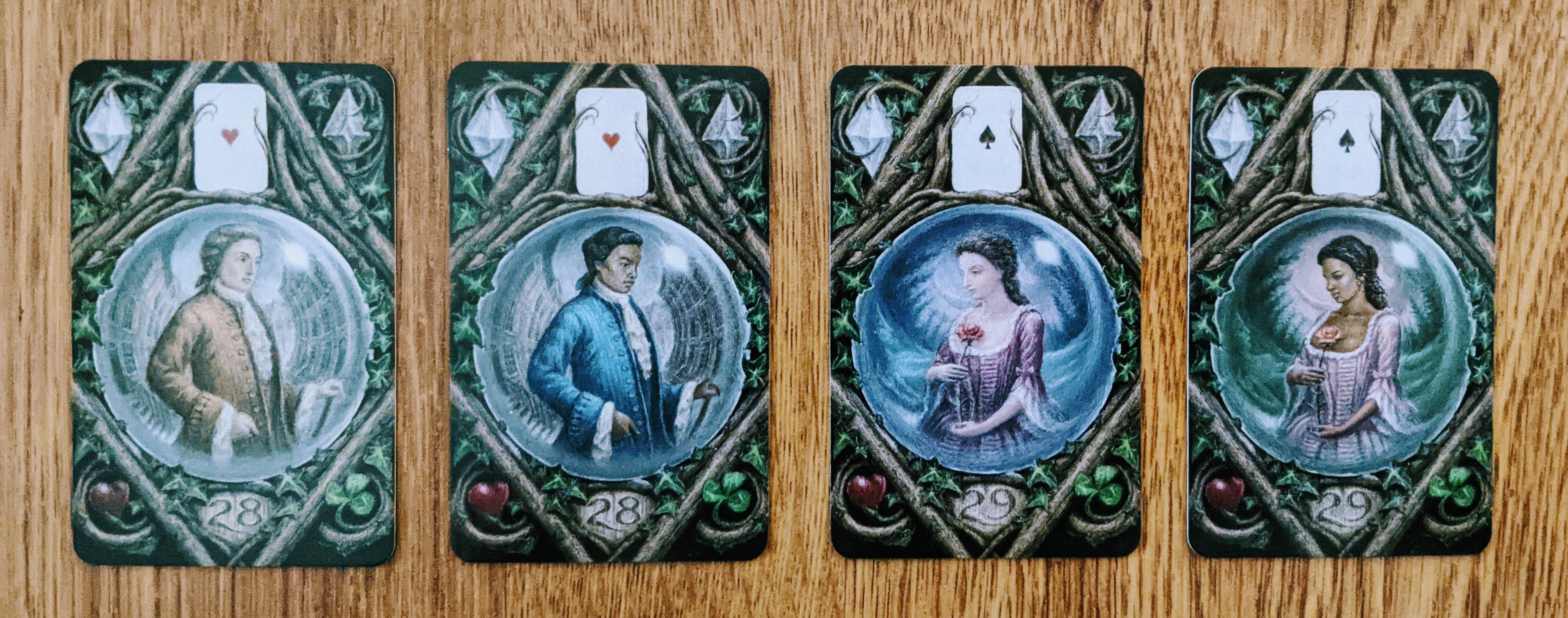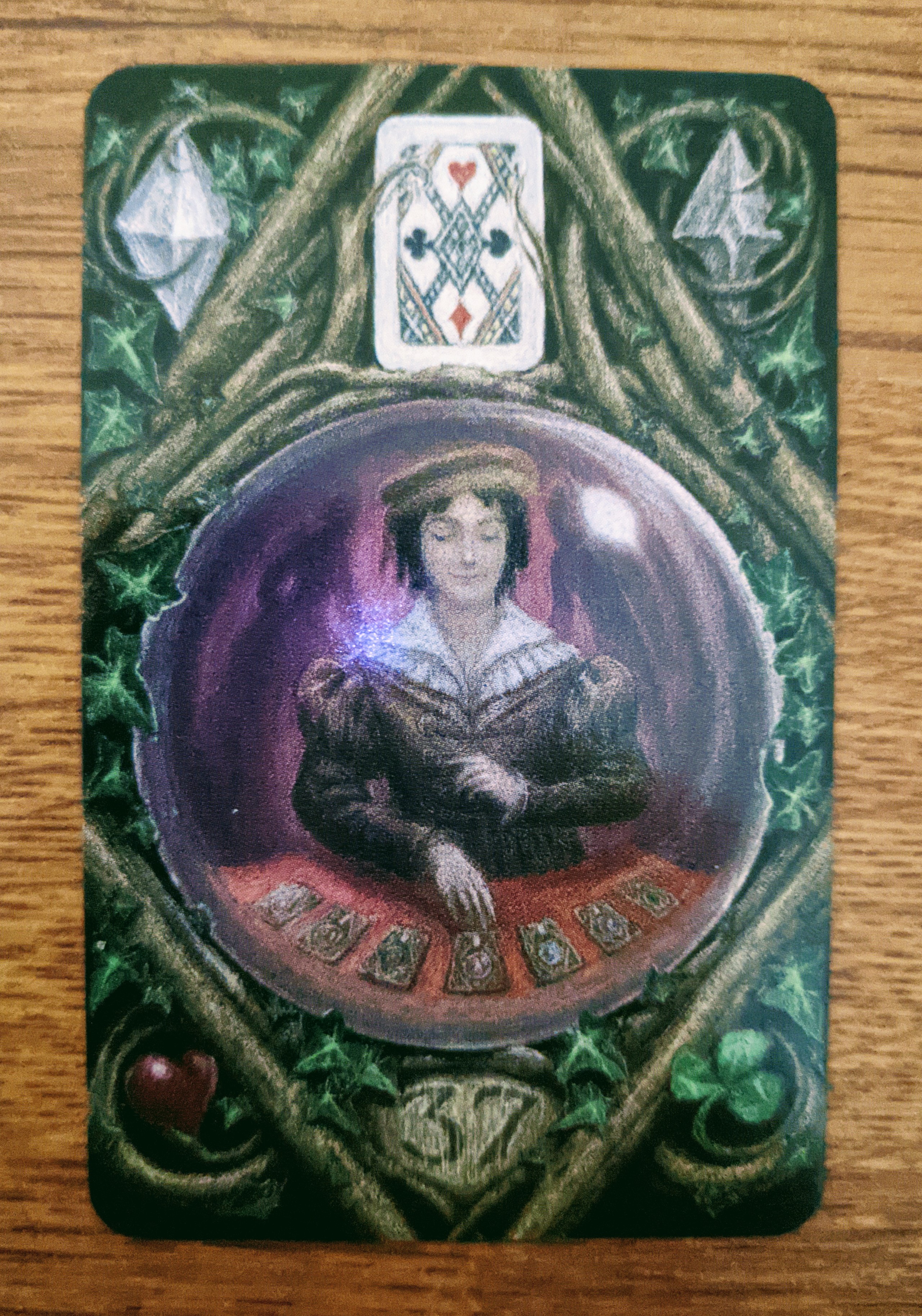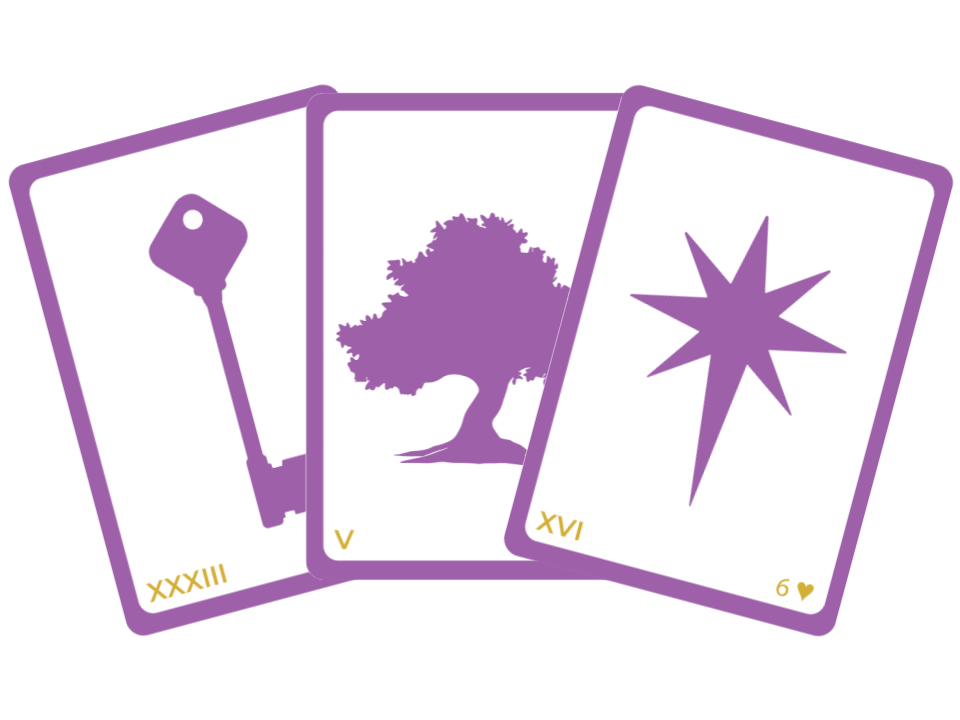
THE ENCHANTED LENORMAND ORACLE BY CAITLIN MATTHEWS
NOTE. In this post, “Guidebook” refers to the booklet accompanying The Enchanted Lenormand Oracle, and “Book” refers to The Complete Lenormand Oracle Handbook by Caitlin Matthews.
There is no question that Caitlin Matthews is one of the most distinguished authors in all things spirituality and divination. She has shared her wisdom and depth through many works.
Lenormand is not Matthews’s sole focus. She also covers Tarot, Celtic mythology, and magic, to mention a few. Her coverage is not only diverse, but also in-depth and refined, which is telling of her exquisite taste and polish in treating these topics and furthering our knowledge.
Her take on Lenormand goes far beyond expectations as she delivers one of the most detailed works on the subject: The Complete Lenormand Oracle Handbook.
In it, she offers a completely original and astounding insight into the cards: The Lenormand Universe - a very special treat for another day.
Her Lenormand deck, The Enchanted Lenormand Oracle, is also an amazing work. It is faithful to her Celtic spirit and comes with a guidebook that is abundant in information and techniques.
DECK DESIGN & UNIQUE FEATURES
Like many Lenormand decks, Matthews’s deck is small. This is one of the first features I look at because I have big hands and long fingers, so I prefer somewhat larger decks.
At the same time, when cards are too big, laying them out in a Grand Tableau can be inconvenient.
Lenormand decks have probably been on the smaller side for the sake of accommodating the Grand Tableau on a reader’s table or surface.
The back of a card has, in its center, four cards, each with a symbol of a suit: Spade, heart, diamond, and club. And at the center of the four cards, there is a crystal ball.
The spade and heart cards are always above, and the diamond and club cards are always below, which means that we can tell whether a card is upright or reversed. This is my preference because Lenormand’s cards are read only upright, though some authors experiment with a reversed meaning.
Above these four cards, there is a heart, and below them a crystal. To their left, there is a diamond-like stone that appears to be a spearhead, and to their right, a three-leaf clover.
[insert image of box cards back of card]
On the front of a card, the main symbol or emblem is drawn within a crystal ball. The pip card is above it, and the card number below. All three elements are within a diamond shaped by tree branches.
At the top left corner, there is the same crystal illustration found on the back. At the top right, there is the spearhead. At the bottom left, the heart. And at the bottom right, the three-leaf clover.
The dark green, the wood, and the dense illustration, all give a card the feel of a beautiful, mysterious forest.
Their design is quite attractive and carefully crafted, but I generally prefer crisper distinctions - in color and design - between the main emblem of the card, its insets (pip and number), the background, and additional design and artistic features.
It makes it easier to connect with the card without ‘looking’ for the emblem, and it is certainly better for my purposes of filming Lenormand readings on video.
The Enchanted Lenormand deck has 39 cards, whereas the standard Petit Jeu has 36.
Matthews offers two additional Man and Woman cards, which has become a common practice by Lenormand authors in recent years to account for the diversity of ethnicities and relationships.
Matthews’s Man and Woman cards come in one white and one black/brown each.

In addition to offering these alternatives for the significators, Matthews adds card 37: The Diviner.
The Diviner does not have a pip. Instead, the four suits are illustrated on a card above the main illustration, and the number 37 below it. Matthews suggests the Diviner represents Mlle. Lenormand herself. How interesting!
She writes:
“The non-traditional Diviner is an extra card in the Enchanted Lenormand Oracle, representing Marie-Anne Adelaide Lenormand herself. Divination offers a snapshot of conditions seen projected from the present moment, but not the entire picture as it will be. The Diviner offers truth and guidance so you can use the consultant feature of this card. When this card appears in a line-up, listen more deeply to what is being suggested: test it out before you accept its message.” (Guidebook, p. 108)
You might already be hearing my skepticism about adding more cards to the deck, though Matthews’s Diviner is quite inspirational.
Still, isn't it true of all divination at all times that it “offers a snapshot of conditions seen [to] project from the present moment, but not the entire picture as it will be”?
I think so.
So, I do not feel that a card is needed to affirm that. Instead, it is a principle that guides our reading practice at all times.
On this note, it is important to think about what principles stand behind your divination approach and what ethics guide how and why you read. These are topics we address in the third Master Course of Lenormand Reader’s Certification Program.
The Diviner is really about the seer, and Matthews uses keywords like prediction, oracle, information-gathering, and others that revolve around the notion of truth-seeking from a higher perspective (p. 108).
In addition to these unique features, Matthews uses the word Broom instead of the Whip (card 11), and the word Crossing instead of the Cross (card 36).

CARD MEANINGS
Matthews’s Guidebook to the cards is abundant in information.
Each card has two pages of text, and is explained across the categories of Impact, Keywords, People, Love. Work, Finance & Business, Wellbeing, Compare, Playing Card, and In Story.
The Impact category is broad and appears to offer the kind of energy and theme the card brings to the reading.
Keywords are a standard category used by almost every Lenormand author to explain a card's meaning. Matthews’s keyword list for each card is generous and well thought-out.
The categories of People through Wellbeing are what I call correspondences, meaning what each card means for different contexts.
The Compare paragraph compares a card with other cards of the deck. This is a good way to refine one’s understanding of the cards and avoid confusing them.
The Playing Card is the pip associated with each card.
And In Story describes how the card figures in various myths, mythologies, and story-telling techniques, which I expect to be an area that is very close to Matthews’s bardic heart.
In addition to these categories, which focus on the card's meaning, Matthews offers a section for Selected Combinations, where she lists several combination meanings.
I’ve always felt that Mattews’s meanings for card combinations are insightful but sometimes curious.
For example, the Scythe and Mountain suggest “savage wilderness, cut off from civilization, brink of survival.” (Guidebook, p. 55)
An interesting association that Matthews mentions is the compass directions. They come through the Ship in four different combinations: With the Lily, it is the north. With the Sun, south. With the Bouquet (or Flowers), east. And with the Scythe it is west. (Guidebook, pp. 40-41)
Matthews offers a specific set of techniques to interpret card combinations, and I detail them in the next section.
As for timing, Matthews admits that timing is difficult to read accurately - not only in cards, but in any form of divination. This tells me that she has the right approach with divination (not that I ever questioned her expertise), as anyone who tells you they can predict timing accurately is either insufficiently practiced or questionable.
She writes:
“Timing is notoriously difficult to predict when divining. I have developed my own way of establishing timing by reference to the playing cards, rather than to the crystal ball images” [i.e. the main symbols]. (Guidebook, p. 151)
For the timing use of the Houses, Matthews considers a topic and identifies a card that represents it (what I call a signifier as opposed to a significator).
Then, using the whole deck, she lays out a Grand Tableau of Nines and looks for that topic card. The House on which this card lands offers the timing but when examined for how near or far it is from the significator. She writes:
“When your topic card lands on a house 1-2 positions away from the significator, you read the house as “near”; when the cards are three or more places from the significator, you read them as “far”.” (Guidebook, p. 152)
For example, let’s suppose your topic card lands on the house of Coffin. The timing is “midnight, [or] a few months off” if the Coffin is near the significator, and it is “sooner than you’d like”, if it is far from the significator. (p. 152)
Matthews does not make this explicit, but I assume that the location of the significator that we look at for this timing technique is the one on the Tableau that is drawn - not the house of the Man or Woman.
She offers the full list of timing for each card toward the end of the Guidebook (pp. 152-153), and I think this is a really interesting, if not groundbreaking, method to figure out timing. I encourage you to explore it to see if you like it.
Overall, Matthews’s in-depth explanation of the cards will give you much to inspire your own take on their meaning so you can interpret them for any question and context.
But keep in mind that there are as many correspondences as there are themes and topics. That is why it is not practical to try and memorize every card combination.
Instead, it is best to get a feel for the essence of the cards, and then use the context of the question as well as your intuition to interpret the reading.
CARD COMBINATION TECHNIQUES
Like all serious Lenormand Readers, Matthews pays close attention to card combining techniques.
The order of the cards and their position within a line seem to be central to her interpretation approach.
This is not my personal approach, but it does come in handy in some combinations and for some questions. I usually combine the cards in whatever ways make sense for the reading, and I find that the cards themselves guide me with this.
Matthews offers five methods for making sense of the cards in combinations: (1) Card pairing, (2) forward narrative, (3) opening triplet, (4) middle triplet, and (5) end triplet (pp. 22-23).
- Card pairing method
In this method, the second card is an adjective, verb, or adverb of the first. In other words, the second card describes the first. Here are some examples by Matthews:
Example 1:
Stork + Moon = An honorable change.
Moon + Stork = Changing work or reputation.
(Guidebook, p. 17)
Example 2:
House + Mouse = Loss of home, depreciating property.
Mouse + House = Domestic loss or burglary.
(Guidebook, p. 22)
Example 3:
Man + Star = A scientific man, very clear, inspirational.
Star + Man = Male scientist, virile intelligence, masculine innovator.
(Guidebook, p. 24)
Matthews offers many more examples in her Guidebook, and I encourage you to explore them.
- Forward narrative method
Here, we string the cards into a sentence like beads in a necklace. This is probably closest to my approach, especially when reading longer lines like in a Grand Tableau.
Here are some examples by Matthews:
Example 1:
Moon + Stork + Anchor = Work changes finally stabilize.
(Guidebook, p. 22)
Example 2:
Path + Broom (Whip) + Lily
I decide to clean up my act and behave with maturity.
The decision to rebel leads ultimately to peace.
Broom + Lily + Path
I sweep away the old influences and choose a new direction.
The disputants peacefully find alternative ways.
Lily + Path + Broom
As an elder I choose my own way and speak my mind.
The winter routes need clearing.
(Guidebook, p. 25)
Matthews suggests, “Don’t be afraid to link up your statements by joining words as the sequence suggests to you: words such as “and”, “but”, “with” and “then” are useful, as are “from”, “to”, “for”, “as” and “when” etc. Try reading your triplets in different ways, as outlined above: opt for the one that is most eloquent.” (Guidebook, p. 26)
- Opening triplet
With this method, the emphasis is on the first card. We can think of it as setting the theme for the rest of the line.
For example, Birds + Garden + Child = Telephone call where you hear about a club that’s starting up. (Guidebook, p. 23)
- Middle triplet
Here , the greatest emphasis is on middle card, such that it is described by the other 2 cards.
For example, Birds + Garden + Child = Talking about a venue for young people. (Guidebook, p. 23)
- End triplet
And here, the greatest emphasis is on the last card, which is the outcome card. I use this approach often in my readings.
For example, Birds + Garden + Child = Popular public support won through simplicity. (Guidebook, p. 23)
LAYOUTS AND INTERPRETATION TECHNIQUES
Matthews explains quite a few layouts in her Guidebook, including the Portrait and Grand Tableau, which she calls the Big Picture.
Her approach to layouts is closer to Tarot style than what I consider Tableau-style, meaning cards in certain positions tell about specific aspects of the question being asked about.
For example, in her Encounter spread which is focused on a relationship, Matthews suggests that cards 1, 2, 3, and 4, are about what each person understands about the relationship. Cards 5, 6, 7, and 8, tell of what each is willing to bring to the table. And cards A-D cover the dynamics between the two.

This Tarot-approach to layouts is always fun to try, and the thing about it is that card positions can indicate anything you want them to, to help you understand the situation you’re asking about.
With the Portrait and Grand Tableau, Matthews follows a more classical Lenormand Tableau-style approach which simply involves reading the rows, columns, and diagonals, and a few key card structures, to take away the answer to a question.
LRCP students often ask me about whether there are specific Lenormand layouts to be used with specific topics, and the answer is simply no!
That’s because there is no need for Tarot-style layouts with Lenormand, because any Lenormand line, portrait, or Tableau, can be used to answer any question no matter what topic it is about.
In Lenormand layouts, cards are read together, not individually on specific card positions like in Tarot.
We can create Tarot-style spreads for a Lenormand reading, but single lines, a Portrait or a Tableau will do just as well to answer the question.
Matthews also offers suggestions for the kinds of questions to be asked with Lenormand and, I would think, divination as a whole.
She suggests that preferred questions are focused on learning about a topic, getting guidance, knowing the consequences of a specific course of action, and how to move forward from an issue or point in time.
On the other hand, she suggests that the types of questions that are best avoided are yes/no, choices, and “should I” type of questions.
She also advises against asking about another person, framing questions in a negative form, and asking the same question twice in the same session. (Guidebook, p. 21)
I generally resonate with these suggestions because I feel divination is meant to empower - not direct - a person’s will.
Still, some yes/no and choices questions are okay, and relationships being such a big part of our life, I feel that it’s also okay to inquire about others sometimes.
It really comes down to our intentions. With divination, magick, and really all of life, having sincere intentions and focusing on the good will deliver best results.
Asking the same question multiple times is a big no-no in all divination, but to say that we never do this would be lying!
We all obsess about an issue at times. And those who have divination skills, will ask about the same issue a few times.
When this happens, it matters most to realize that the readings will end up being inaccurate. If you’re okay with that, then play away with your cards just for the heck of it.
But if you don’t realize that these repeated readings can dwindle into accuracy, then you’re best disciplining yourself until you can disconnect from a reading.
QUOTABLE QUOTES
There is no shortage of insights that can be picked out of Matthews’s Guidebook to the Enchanted Lenormand Oracle cards.
In addition to the ones I quoted above, there are a few more that I’d like to add.
In describing the unique depth that comes from the simplicity of Lenormand’s cards, Matthews writes:
“While the central images are plain, the layers of meaning that they can reveal are quite remarkable, especially as you grow more familiar with them.” (Guidebook p. 6)
So true! This characteristic of Lenormand’s cards is probably what appeals to many of us when we first come across them.
She also writes:
“Many diviners who take up Lenormand divination are astounded by how accurate the cards can be, but some beginners are dismayed that they cannot immediately access their intuition or inspiration in the early days in the same way as when they read the tarot. Do not give up! When you have learned the basic meaning of each card, your intuition will quickly pick the scent of the issue, and make connections between pairs and triplets. You will soon be able to scan tableaux to see the stand-out message and interpret with confidence.” (Guidebook p. 11)
This accurately describes the experience of students in the Program. They often feel this way when they’re first getting started and in time they become at ease with how Lenormand works.
Finally, I want to quote these lines from Matthews’s Guidebook:
“This is an enchanted world in which, whenever you lay the cards for yourself or another person, you are tracking the path of a quest. Like any hero and heroine of folk story, in life you encounter challenges where you experience fear, danger, doubt, and confusion. But along the way there are people, animals, objects and places that will protect, defend, shelter and counsel you.” (Guidebook p. 6)
In my opinion, Matthew’s Celtic background is just about everything that drives her poetic soul. This quote really captures how divination is so much more than just fortune telling.
It is a process of discovery, a companion on our journey. How lucky we are to be able to see.
Carry on, Diviner, carry on!
NOTE ABOUT THIS POST This blog post and/or video are produced in good faith to promote the author’s work and bring together the Lenormand community. If the author(s) or his/her representative(s) has any concern with the information presented, kindly write to Layla, the Lenormand Reader. Layla, the Lenormand Reader, reserves all rights.

Want To Become A Lenormand Reader?
Lenormand Reader’s Certification Program is the only one of its kind, in size and in depth, to help you master the amazing Lenormand deck. This Program is filled with knowledge and practice accumulated through 20+ years of study and practice. It is organized into a real body of knowledge and delivered with best in class, online, on-demand video. Join the waitlist so you secure your spot when registration opens.
Join Lenormand Reader’s Certification Program
